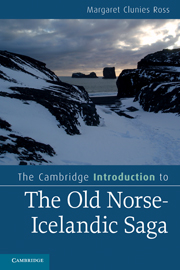Book contents
- Frontmatter
- Contents
- Tables
- A preface on practical issues
- Acknowledgements
- Abbreviations
- Chapter 1 Medieval Iceland
- Chapter 2 What is an Old Norse-Icelandic saga?
- Chapter 3 The genesis of the Icelandic saga
- Chapter 4 Saga chronology
- Chapter 5 Saga subjects and settings
- Chapter 6 Saga mode, style and point of view
- Chapter 7 Saga structures
- Chapter 8 The material record: how we know the sagas
- Chapter 9 Changing understandings of the sagas
- Notes
- Glossary of technical terms
- Guide to further reading
- References to volumes in the Íslenzk fornrit editions of Icelandic sagas
- Index
Chapter 5 - Saga subjects and settings
Published online by Cambridge University Press: 05 June 2012
- Frontmatter
- Contents
- Tables
- A preface on practical issues
- Acknowledgements
- Abbreviations
- Chapter 1 Medieval Iceland
- Chapter 2 What is an Old Norse-Icelandic saga?
- Chapter 3 The genesis of the Icelandic saga
- Chapter 4 Saga chronology
- Chapter 5 Saga subjects and settings
- Chapter 6 Saga mode, style and point of view
- Chapter 7 Saga structures
- Chapter 8 The material record: how we know the sagas
- Chapter 9 Changing understandings of the sagas
- Notes
- Glossary of technical terms
- Guide to further reading
- References to volumes in the Íslenzk fornrit editions of Icelandic sagas
- Index
Summary
This chapter is concerned with the subject-matter treated in sagas and will show that we can distinguish broadly between sub-genres of the saga on the basis of their subject-matter, which in its turn is related to the specific historical and geographical settings of the various sub-genres. The narrative mode and style of these sub-genres is the main subject of Chapter 6; in Chapter 5 the subject-matter and its setting in time and space will be the centre of attention. This chapter will propose that both chronology and geography can be seen to act as consistent markers of sub-generic identity in the literary world of the medieval saga and must have been perceived by their contemporary audiences as indicators of generic affiliation and thus of the range of interpretative possibilities available to them. As we shall see, these constituent elements of saga writing function, just as much as characterisation, as determiners of presumed medieval audience and modern readerly response, without their creators having to invoke specific cultural assumptions directly.
Time and place in the saga world
In terms of the medieval Icelandic perspective on world history, saga time ranges from prehistory to the present time, seen from the saga audience's viewpoint, while saga geography extends from Iceland to the rest of Scandinavia, then west to the British Isles, the North Atlantic, Greenland and North America, and south and east to the Mediterranean world, Russia and the Middle East. These historical and geographical settings map onto specific saga sub-genres.
- Type
- Chapter
- Information
- Publisher: Cambridge University PressPrint publication year: 2010
- 1
- Cited by



